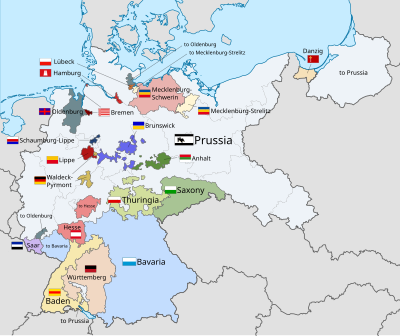
Back ولايات جمهورية فايمار Arabic Organización territorial de la República de Weimar AST Estats de la República de Weimar Catalan Organización territorial de la República de Weimar Spanish Negara bagian Republik Weimar ID Stati della Repubblica di Weimar Italian Negeri-negeri Republik Weimar Malay Административное деление Веймарской республики Russian States of the Weimar Republic SIMPLE Weimar Cumhuriyeti döneminde kurulan Alman devletleri Turkish

The states of the Weimar Republic were the first-level administrative divisions and constituent states of the Weimar Republic. The states were established in 1918–1920 following the German Empire's defeat in World War I and the territorial losses that came with it. They were based on the 22 states and three city-states of the German Empire. During the revolution of 1918–1919, the states abolished their local monarchies and adopted republican constitutions.
Several attempts were made to reorganize the states under the Weimar Republic, particularly because of Prussia's disproportionately large size and influence, but the attempts were unsuccessful. The one significant change was the formation of Thuringia from a number of smaller states.
The Weimar Constitution created a federal republic with certain basic powers reserved for the federal government, some powers shared between the central government and the states, and the remainder in the hands of the states. The federal government was given the power in Article 48 of the Constitution to use its armed forces against states that did not fulfill their obligations under Germany's laws. The power was used four times during the life of the Republic. In its early years, the Weimar Republic also saw a number of separatist movements and attempts to set up soviet-style governments, but all of them were short lived.